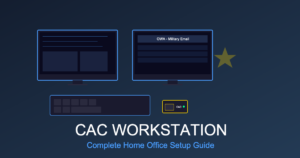Understanding the Common Access Card (CAC)
The Common Access Card, often abbreviated as CAC, is a smart card issued by the United States Department of Defense (DoD). It’s a crucial piece of identification for active duty military personnel, civilian employees, and certain contractors. This card serves multiple purposes, including identity proof, access to DoD computer networks, and even as an entry card to buildings. The CAC is not just a simple ID card; it contains several key features that make it secure and functional.
Embedded Microchip
At the core of the CAC is its embedded microchip. This chip is what differentiates it from a traditional identification card. It contains encrypted data important for both identity verification and access to secure networks. The chip stores personal information safely and allows secure authentication. When used with a compatible card reader, it ensures that only authorized individuals gain access to sensitive DoD systems and networks.
Magnetic Stripe
The back of a Common Access Card features a magnetic stripe. This part of the card contains additional data pertinent to the cardholder. Magnetic stripes are a legacy feature that supports situations where newer technologies might not be available. It ensures backward compatibility with older systems. While it might seem like an outdated technology, it is a reliable method for offline identity verification.
Bar Codes
The CAC incorporates both 1D and 2D bar codes. These bar codes contain specific information about the cardholder, like their unique identifier and certain biometric data. 1D bar codes, often basic, usually contain numerical data. The more complex 2D bar codes can store larger amounts of data securely. Both types are machine-readable, streamlining identification processes at checkpoints or entry points.
Photographic Identification
A critical visual component of the CAC is the photographic ID. This image ensures that personnel showing the card can be visually matched to some degree. While most underlying technologies focus on computer systems and automated processes, the photograph allows human operators to perform quick visual checks, making the card usable even without electronic equipment.
Personal Identification Number (PIN)
Every CAC is paired with a Personal Identification Number. Users must enter their PIN when accessing computer systems with the card. This requirement adds a layer of security, ensuring that possession of the card alone is insufficient for accessing sensitive information. It implements a basic form of two-factor authentication, as both something you have (the card) and something you know (the PIN) are needed.
Biometric Data
The CAC also contains biometric data. Typically, this might include fingerprint information. Such data is crucial for ensuring that the individual using the card is indeed the person to whom it was issued. Biometric verification provides a higher level of security in sensitive operations, minimizing the risk of identity theft or card misuse.
Contact and Contactless Interfaces
CACs are designed with both contact and contactless interfaces. The contact interface requires the card to be inserted into a reader, ensuring physical connectivity for accessing data. The contactless functionality, on the other hand, employs RFID technology. This allows the card to communicate with a reader without direct physical contact, which is useful for quick access scenarios like door entries.
Certificates and Encryption
Digital certificates are a fundamental component of the CAC. These certificates enable secure communications and ensure authenticity through encryption. The card holds a personal identity certificate, a digital signature certificate, and often an encryption certificate. These allow users to securely sign emails, encrypt messages, and validate the origin of communications within DoD systems.
Public Key Infrastructure (PKI)
The CAC makes use of the Public Key Infrastructure (PKI). PKI is crucial for various security operations like encryption and digital signatures. The infrastructure allows for robust, scalable, and secure identity verification. CACs depend on PKI to perform secure transactions, ensuring data integrity and user authenticity in digital communications.
Security Features
The card employs several security features to prevent tampering and counterfeiting. Beyond digital encryption, the card itself is physically robust and hard to duplicate. Watermarks, holographic images, and microtext are some of the physical security measures embedded in the card. These features make it clear if a card has been altered or is fraudulent.
Role in Physical and Logical Access
CACs are used both for physical access to facilities and logical access to information systems. To enter certain DoD buildings, the card provides secure verification of identity. Similarly, to log into DoD networks, the card verifies the user, ensuring they have the necessary clearance. This dual-role capability streamlines identity verification across different domains.
Renewal and Revocation
The lifespan of a Common Access Card is typically three years, after which it must be renewed. This renewal process involves verifying the cardholder’s information and updating security features as needed. If compromised, a card can be revoked at any time. Revocation ensures that the card’s credentials are invalidated, blocking access until a replacement is issued.
Integration with Other Systems
The CAC is often integrated with various other systems used by the DoD. From healthcare services to payroll to building access, one card serves multiple functions. This integration helps streamline operations, reduce the number of identification items needed per person, and enhance overall security through centralized management.
Impact on Daily Operations
For cardholders, the CAC is more than just an ID card. It’s an essential tool for daily operations. Whether logging into a computer, accessing secure emails, or passing through security checkpoints, it’s a constant companion. The card’s multifunctionality reduces the need for multiple keys, badges, or passwords, simplifying life for DoD personnel.









